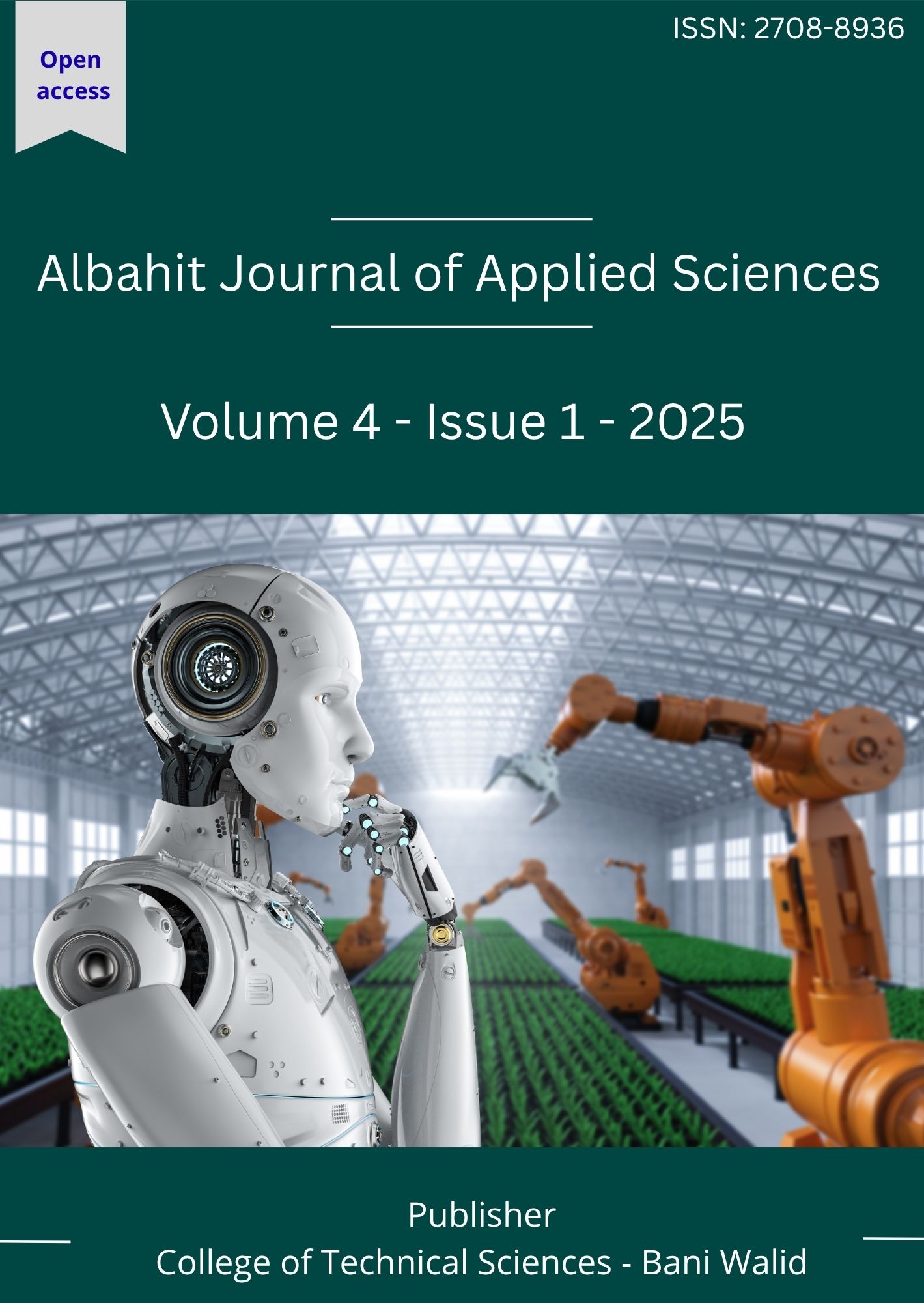تحديد إعادة توزيع الإجهاد المتبقي لسبيكة الألومنيوم T351 2024 بواسطة اختبار صلادة فيكرز
الكلمات المفتاحية:
الصلادة الدقيقة، الإجهاد المتبقي، القصف بالكريات، التعب، وسبائك الألومنيومالملخص
This study investigated the evolution of microhardness, fracture toughness, and residual stress in a 2024-T351 aluminum alloy under cyclic loading after various shot peening treatments. A modified Vickers indentation instrument, coupled with three different indentation models, was used to measure these properties. The experiments were conducted using variable amplitude tests on samples subjected to three different shot peening intensities: 4-6A, 6-8A, and 8-10A. The samples were tested under cyclic loading at two applied stress levels, 170 MPa and 280 MPa, for 1, 2, 10, 1000, and 10,000 cycles. Experimental results show that microhardness was reduced by 34% for samples treated with an 8-10A shot peening intensity after 10,000 cycles under a -280 MPa load. The reduction in microhardness is attributed to the relaxation of residual stress, with the rate of reduction being influenced by the material's percentage of cold work.
المراجع
1. Ali, F. S., & Aimen, A. (2022). Analysis of residual stresses induced by mechanical shot peening processes using the X-ray diffraction technique and finite element method of 2024-T351 aluminum alloy. Albahit Journal of Applied Sciences, 35–40.
2. Ali, F. S., & Abdoulhdi, A. (2019). Evaluation of residual stress relaxation induced by shot peening parameters and its effect on fatigue of 2024-T351 aluminum alloy. Test Engineering and Management, 5693–5701.
3. Ali, F. S., & Suliman, O. (2018). Experimental and numerical investigation of surface residual stress relaxation of A2024-T351 aluminium alloy. International Journal of Pure and Applied Mathematics.
4. American Society for Testing and Materials (ASTM). (2001). E3-2001: Standard method of preparation of metallographic specimens. Annual Book of ASTM Standards, 03.01. Philadelphia, PA: ASTM.
5. American Society for Testing and Materials (ASTM). (2003). E384-99: Standard test method for microhardness of materials. Annual Book of ASTM Standards, 03.01. Philadelphia, PA: ASTM.
6. ASTM. (2021). 1-0011 constant amplitude fatigue testing of metallic materials. In Airbus Industrial, Engineering Directorate (pp. 1–24).
7. Hill, R., Lee, E. H., & Tupper, S. J. (1947). The theory of wedge indentation of ductile materials. Proceedings of the Institution of Mechanical Engineers, 273–289.
8. Johnson, L. (2017). Contact mechanics. Journal of Mechanical Engineering Science.
9. Kuyucak, S., & Sahoo, M. (1996). A review of the machinability of copper-base alloys. Canadian Metallurgical Quarterly, 35(1), 1–15.
10. Mattson, R., & Coleman, W. (1954). Effect of shot-peening variables and residual stresses on the fatigue life of leaf-spring specimens. SAE Technical Paper.
11. Meyer, E. (1908). Z. Ver. Deutsche Ing., 52, 645–654.
12. Peitl, O., & Serbena, F. C. (2023). Internal residual stress measurements in a bioactive glass–ceramic using Vickers indentation. Journal of the American Ceramic Society, 2359–2368.
13. Reddy, V., Rambabu, V., & Mrudula, G. (2022). Effect of shot peening on microstructural features, residual stress behavior, and hardness of aluminum alloy. Reviews on Advanced Materials Science, 102–116.
14. Story, J., Jarvis, G., Zonker, H., & Murtha, S. (1993). Issues and trends in automotive aluminum sheet forming. SAE Technical Paper.
15. Torres, M., & Voorwald, H. (2024). An evaluation of shot peening, residual stress and stress relaxation on the fatigue life of AISI 4340 steel. International Journal of Fatigue, 24(8), 877–886.
16. Zaroog, O. S., Ali, A., Sahari, B., & Zahari, R. (2011). Modeling of residual stress relaxation of fatigue in 2024-T351 aluminium alloy. International Journal of Fatigue, 33(2), 279–285.
17. Zaroog, O. S., Ali, A., Sahari, B., & Zahari, R. (2024). Relaxation of residual stress part 2: Relaxation of stage 2. American Journal of Engineering and Applied Sciences, 2(4), 759.
18. Zhuang, W. Z., & Halford, G. R. (2021). Investigation of residual stress relaxation under cyclic load. International Journal of Fatigue, 23, 31–37.







